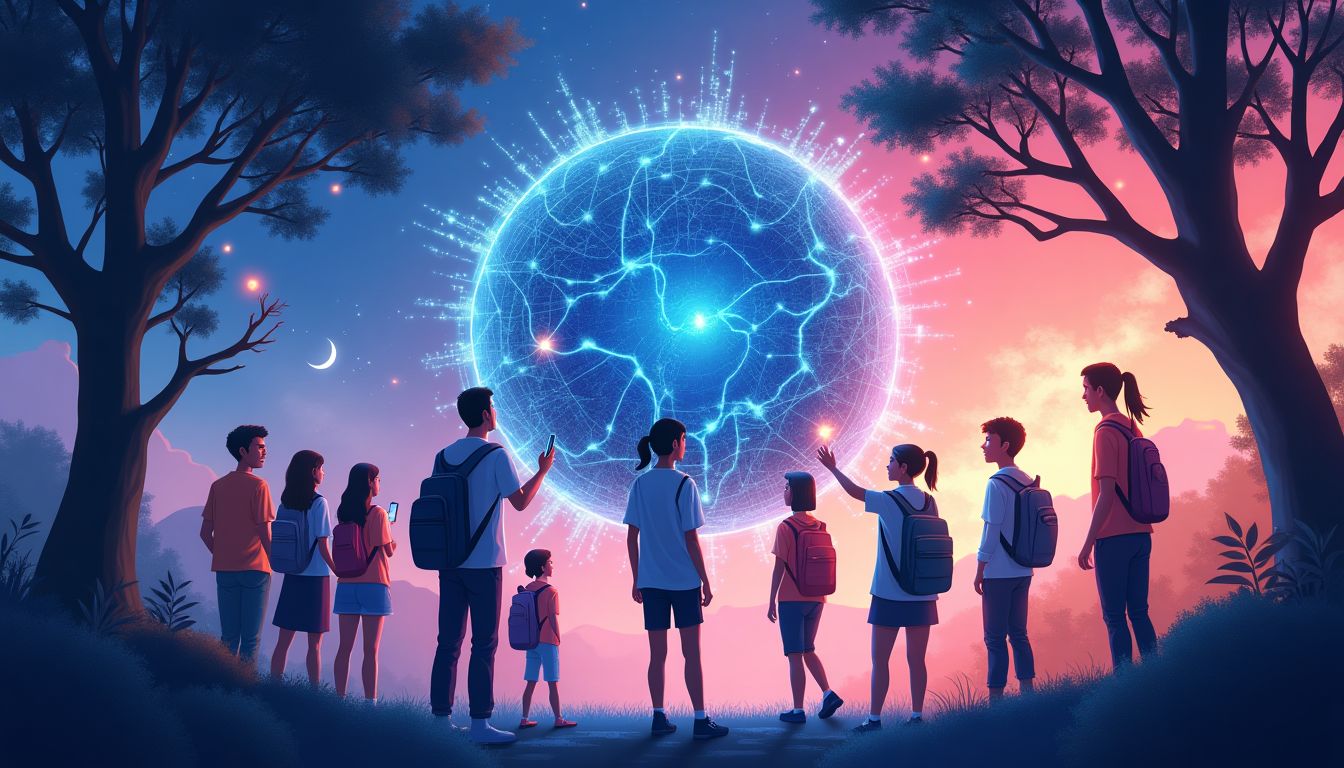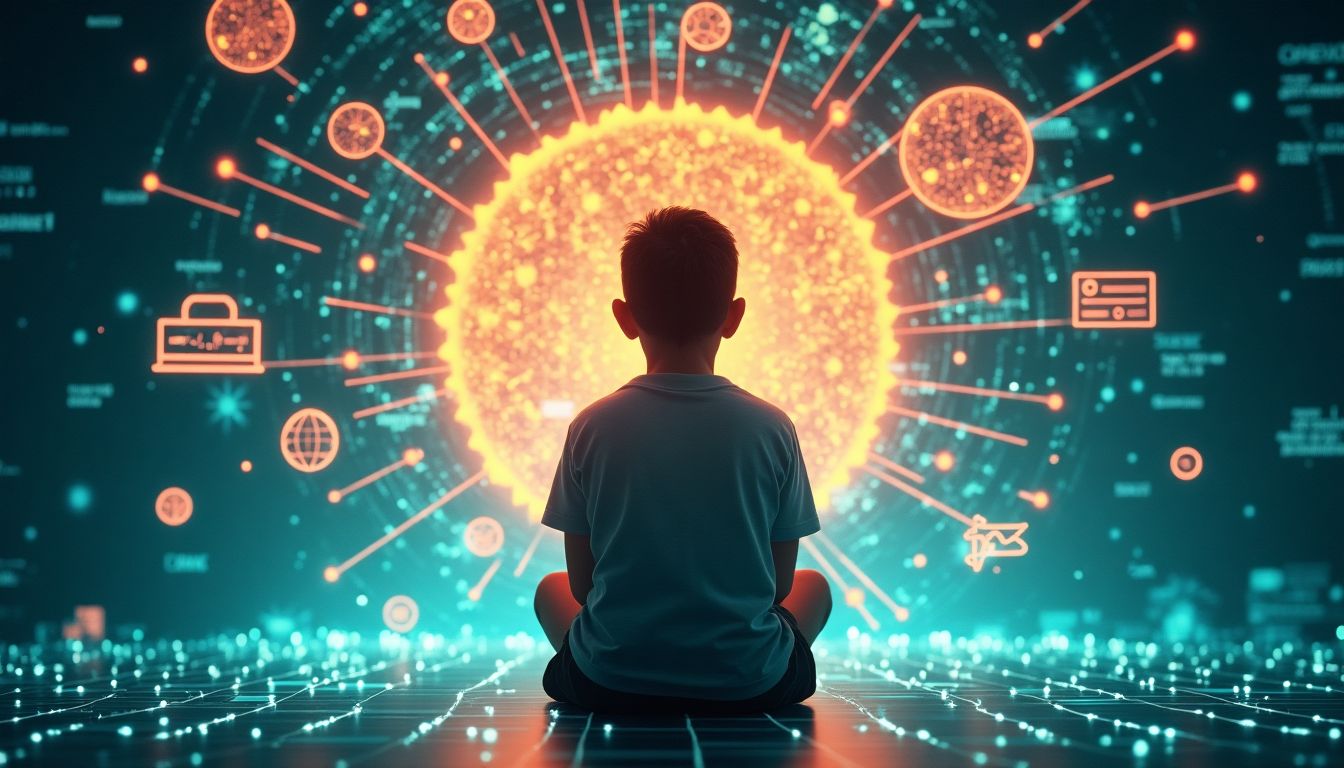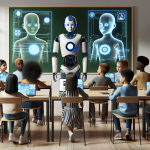Reimagining Education: Could AGI Make Schools Obsolete?
Everybody to their seats please. C'mon Mr. Blake, Ms Johnson -we don't have all day. Let's go, let's go, hurry up...class is in session!
What if the chalkboard, the bell, and the teacher’s stern gaze were destined for the museum? Albert Einstein once quipped, “The only thing that interferes with my learning is my education.” Fast forward to 2025, and we’re standing on the precipice of a seismic shift in how we learn. Artificial General Intelligence (AGI)—a system smarter than the smartest human—could render the traditional classroom as outdated as the abacus. But is this the dawn of an educational utopia or the start of a dystopian nightmare?
Renowned futurist Ray Kurzweil, author of *The Singularity is Near*, predicts that AGI will revolutionize every aspect of human life, including education. Meanwhile, Salman Khan, founder of Khan Academy, envisions a future where personalized learning powered by AI becomes the norm. And let’s not forget Yuval Noah Harari, whose book *21 Lessons for the 21st Century* warns of the societal upheaval AI could bring. The question isn’t whether AGI will disrupt education—it’s how.
What if every child had a personal tutor that knew their strengths, weaknesses, and passions? What if learning wasn’t confined to four walls but extended to every corner of the globe? AGI promises to make education hyper-personalized, accessible, and lifelong. But like any powerful tool, it comes with risks. Could AGI widen the gap between the haves and have-nots? Could it replace teachers entirely, leaving kids without human mentors? And what happens to the social fabric of schools—the friendships, the debates, the shared experiences?
This isn’t just about technology; it’s about redefining what it means to learn. It’s about breaking free from the industrial-era model of education and embracing a future where every mind can flourish. So, let’s unpack the flaws of our current system and explore how AGI could be the key to unlocking every child’s potential—or the thing that locks it away forever.
1. The Flaws of Traditional Education: Why AGI is Needed
1.1 One-Size-Fits-All Model
Think about it: 30 kids in a classroom, one teacher, and a curriculum designed for the “average” student. Sounds efficient, right? Wrong. This industrial-era model of education is about as effective as teaching a fish to climb a tree. Every child learns differently—some are visual learners, others thrive in hands-on environments, and some need more time to grasp concepts. Yet, traditional schools plod along like a factory assembly line, churning out graduates who’ve learned to memorize, not innovate. AGI could change that by tailoring lessons to each student’s unique learning style, ensuring no one gets left behind.
1.2 Inequities in Access
Education should be a right, not a privilege. But in reality, access to quality education is often determined by zip code. Kids in affluent areas get state-of-the-art facilities, while those in underserved communities make do with crumbling classrooms and outdated textbooks. AGI could level the playing field by delivering high-quality education to anyone with an internet connection. Imagine a child in rural Kenya learning calculus from the same AI tutor as a kid in New York City. Now that’s what we call equity.
1.3 Outdated Curricula
Here’s a fun fact: the current education system was designed during the Industrial Revolution to churn out obedient factory workers. Fast forward to 2025, and we’re teaching kids skills that won’t even exist by the time they graduate. AGI could solve this by updating curricula in real-time, ensuring students learn the skills they’ll actually need in the workforce—like coding, critical thinking, and emotional intelligence.
1.4 Teacher Burnout
Let’s give teachers some credit: they’re superheroes who shape the minds of future generations. But even superheroes have limits. Overworked and underpaid, many teachers struggle to give each student the attention they deserve. AGI could lighten the load by automating routine tasks like grading and lesson planning, freeing up teachers to focus on what they do best—inspiring and mentoring students.
1.5 The Need for Lifelong Learning
In a world where technology evolves faster than you can say “ChatGPT,” learning can’t stop at graduation. Lifelong learning is the new normal, but traditional education systems aren’t built for it. AGI could change that by offering personalized learning experiences at every stage of life, from kindergarten to retirement. Imagine a world where you can learn a new skill or explore a passion project anytime, anywhere. That’s the future AGI promises—and it’s one we can’t afford to ignore.
2. AGI-Driven Education: A Hyper-Personalized Future
The idea of AGI revolutionizing education isn’t just science fiction—it’s already happening in small ways. Think of tools like Khan Academy or Duolingo, which adapt to your learning pace. Now, imagine that on steroids. AGI could transform education into a deeply personal experience, where the system knows you better than your favorite teacher ever could. No more struggling through material you’ve already mastered or feeling left behind because the class moved too fast. AGI could be the ultimate tutor, mentor, and cheerleader rolled into one.
2.1 Learning at Your Own Pace
Ever had that moment in class where everyone else seems to get it, but you’re still scratching your head? With AGI, that awkwardness disappears. The system assesses your understanding in real-time, giving you extra examples, practice problems, or even breaking concepts into bite-sized pieces until you’ve got it down. Want to spend a week on quadratic equations? Go for it. Ready to breeze through Shakespeare? AGI’s got your back. It’s like having a personal trainer for your brain.
2.2 Adaptive Content Delivery
Traditional education often sticks to a rigid formula: lecture, homework, test, repeat. AGI flips the script. If you’re a visual learner, it might serve up infographics or videos. If you’re more hands-on, it could create interactive simulations. For instance, instead of reading about the water cycle, you might virtually build a cloud and watch it rain. It’s like Netflix, but for learning—and instead of binge-watching, you’re binge-learning (which, let’s be honest, is way more productive).
2.3 Holistic Development
AGI isn’t just about acing math tests—it’s about nurturing the whole person. Imagine an AI that helps you manage stress, develop empathy, or even discover your passion for painting. Apps like Headspace already use AI for mindfulness; AGI could take it further by teaching life skills, emotional intelligence, and creativity. Picture this: after a tough algebra session, your AGI tutor suggests a 10-minute meditation or a quick doodle break. Who says school can’t be fun?
2.4 Global Accessibility
Right now, millions of kids can’t go to school because of poverty, war, or geography. AGI could change that. With just a smartphone and internet access, a child in a remote village could have the same educational opportunities as a kid in New York City. Organizations like UNICEF are already working to bridge the digital divide, and AGI could amplify these efforts. It’s not just about leveling the playing field—it’s about creating a whole new game.
2.5 Continuous Improvement
One of the coolest things about AGI is that it gets better over time. Every interaction with a student teaches it something new, which it uses to refine its methods. It’s like having a teacher who never stops learning—kind of like Arnold Schwarzenegger’s Terminator, but less terrifying and more helpful. The result? A system that’s constantly evolving to meet the needs of every learner.
3. Societal Implications: The Good, the Bad, and the Ugly
As exciting as AGI-driven education sounds, it’s not all sunshine and rainbows. Imagine a world where traditional schools are obsolete. What happens to teachers? What about the social skills kids learn in the playground? AGI could solve some problems but create a whole new set of challenges. Let’s break it down.
3.1 Economic Disruption
If AGI takes over teaching, what happens to the millions of educators worldwide? Some could transition into roles like AI supervisors or mentors, but others might find themselves out of a job. It’s like the industrial revolution all over again—machines replacing humans in the workforce. But hey, at least we’ll have more time for hobbies, right? (Just kidding, we’ll probably be retraining for new careers.)
3.2 Digital Divide
Not everyone has access to the gadgets and internet needed for AGI-driven education. If we’re not careful, AGI could widen the gap between the haves and the have-nots. Imagine a world where rich kids get personalized AI tutors while poor kids are stuck with outdated textbooks. It’s the educational equivalent of first-class vs. economy (and we all know which one has the comfy seats).
3.3 Loss of Human Connection
Schools aren’t just about learning—they’re about making friends, navigating conflicts, and developing social skills. Can AGI replace the lunchroom banter or the thrill of a class field trip? Probably not. While virtual interactions can help, they’re no substitute for face-to-face connections. We’ll need creative solutions to ensure kids still learn how to be, well, human.
3.4 Ethical Concerns
Who’s in charge of AGI-driven education? Will it be governments, corporations, or some mysterious tech overlord? And what about privacy? Imagine an AI that knows every answer you’ve ever gotten wrong—and shares it with your future employers. Yikes. We’ll need strict ethical guidelines to prevent abuse and ensure fairness.
3.5 Cultural Shifts
Education isn’t just about facts and figures—it’s about shaping values, beliefs, and identities. If AGI takes over, how will it handle different cultural perspectives? Will it teach the same curriculum everywhere, or adapt to local traditions and histories? It’s a delicate balance, and one that could reshape societies in ways we can’t yet predict.
4. Technological Challenges: Can We Build This?
Artificial General Intelligence (AGI) is the holy grail of AI development, but achieving it is no small feat. Let’s break down the technological hurdles standing between us and a world where AGI drives education.
4.1 AGI Development
We’ve made strides in narrow AI—systems designed for specific tasks like playing chess or recognizing faces. But AGI, which can think and adapt like a human, is a whole different ballgame. Current AI lacks the ability to generalize knowledge across domains. For example, an AI that’s great at diagnosing diseases might flunk a math test. To achieve AGI, we need breakthroughs in neuroscience, computing, and even philosophy. Researchers at OpenAI and DeepMind are pushing boundaries, but we’re still far from mimicking the human brain’s versatility.
4.2 Infrastructure Requirements
AGI-driven education demands robust infrastructure. High-speed internet, affordable devices, and powerful data centers are non-negotiable. For instance, remote areas in countries like India or Nigeria lack even basic connectivity. Without these resources, AGI’s promise remains out of reach for millions. Governments and private companies must collaborate to bridge this digital divide. Projects like Starlink by SpaceX aim to provide global internet coverage, but scalability and affordability remain challenges.
4.3 Data Privacy and Security
AGI systems will collect vast amounts of sensitive data—learning patterns, emotional states, even biometric information. Protecting this data from breaches and misuse is critical. Imagine a scenario where a hacker manipulates AGI to push biased or harmful content. Robust encryption, ethical guidelines, and strict regulations are essential. Organizations like the FTC and EU are working on frameworks, but enforcement remains inconsistent.
4.4 Interdisciplinary Collaboration
AGI isn’t just a tech problem; it’s a human one. Neuroscientists, educators, psychologists, and AI engineers must work together to create systems that truly understand and nurture learners. For example, insights from Harvard’s education researchers combined with AI expertise from MIT could yield groundbreaking solutions. Collaboration is key, but silos between disciplines often hinder progress.
4.5 Cost and Scalability
Developing AGI is expensive. Training algorithms requires massive computational power, and scaling these systems globally adds to the cost. Who will foot the bill? Governments, corporations, or a mix of both? And how do we ensure AGI-driven education is affordable for all? Subsidies, public-private partnerships, and innovations like cloud computing could help, but these are stopgap measures. Long-term sustainability requires rethinking how we fund education in the digital age.
5. Ethical Considerations: Who Controls the Future of Learning?
AGI-driven education isn’t just about technology; it’s about power, fairness, and human values. Let’s explore the ethical minefields we must navigate to get this right.
5.1 Corporate vs. Public Control
Will AGI education systems be driven by profit or public interest? Companies like Google and Microsoft have the resources to develop AGI, but their motives may prioritize shareholder returns over student outcomes. Public control, on the other hand, could ensure equitable access, but governments often lag in innovation. Striking the right balance is crucial. One solution is to establish oversight bodies comprising educators, technologists, and policymakers to keep AGI in check.
5.2 Bias and Fairness
AGI algorithms learn from data, but data isn’t neutral. If the data reflects societal biases, AGI will too. For example, an AGI trained primarily on Western educational materials might undervalue non-Western perspectives. Ensuring fairness requires diverse datasets, rigorous testing, and ongoing monitoring. Organizations like the Partnership on AI are working on guidelines, but implementation is a long road.
5.3 Accountability
Who’s responsible when AGI makes a mistake? If a student fails because of a flawed algorithm, who takes the blame? Clear accountability frameworks are essential. Perhaps AGI systems could include “black box” features that log decisions, making it easier to trace errors and assign responsibility. Legal systems will also need to evolve to address these new challenges.
5.4 Transparency
AGI’s decision-making processes can feel like a mystery, even to experts. For users—students, parents, and educators—this opacity can be unsettling. Ensuring transparency means designing AGI systems that explain their reasoning in understandable terms. For example, instead of saying, “You need to study more,” an AGI tutor could explain, “Your scores in algebra are lower than in geometry, so let’s focus on these three concepts.” Transparency builds trust, which is crucial for AGI’s acceptance.
5.5 Cultural Sensitivity
Education isn’t one-size-fits-all, and neither should AGI be. A student in Japan might value collaborative learning, while one in the United States might thrive on individual achievement. AGI must adapt to these cultural nuances, respecting and incorporating diverse perspectives. This requires input from local educators and communities, ensuring AGI doesn’t impose a homogenized view of education.
6. AI Solutions: How Would AI Tackle This Issue?
If Artificial General Intelligence (AGI) were tasked with reimagining education, it would approach the challenge systematically and creatively. Here’s a step-by-step breakdown of how AGI could transform learning as we know it:
6.1 Data Collection and Analysis
The foundation of AGI-driven education would be comprehensive data. AGI would gather information on learning styles, preferences, and outcomes from diverse populations globally. By analyzing this data, AGI could identify patterns and create adaptive algorithms tailored to individual needs. For example, platforms like Khan Academy already collect data on student progress, but AGI would take this to a whole new level.
6.2 Develop the AGI Core
Next, AGI would need a robust core system capable of understanding and teaching any subject. This would involve breakthroughs in neuroscience, cognitive psychology, and computing. Collaborations with institutions like MIT and Stanford University would accelerate the development of a self-improving AGI system.
6.3 Create Personalized Curricula
With the AGI core in place, the next step would be designing dynamic, personalized curricula. These lessons would adapt in real-time based on student performance, interests, and goals. Imagine a system that not only teaches math but also knows when to introduce a creative break or a physical activity to keep the learner engaged.
6.4 Ensure Accessibility
AGI-driven education would need to be accessible to all, regardless of socioeconomic status. This requires affordable hardware, like the Raspberry Pi, and scalable software solutions. Partnerships with organizations like UNICEF could help distribute these tools in underserved regions.
6.5 Foster Human Connection
While AGI could handle the cognitive aspects of learning, human interaction remains crucial. AGI would integrate virtual and in-person interactions, leveraging platforms like Zoom and Microsoft Teams to create collaborative learning environments.
6.6 Continuous Monitoring and Feedback
Finally, AGI would continuously monitor student progress and refine its teaching methods. This feedback loop ensures that the system evolves and improves over time, making education more effective and personalized.
Action Schedule/Roadmap
Here’s a detailed roadmap for implementing AGI-driven education:
- Day 1: Assemble a multidisciplinary team of neuroscientists, educators, AI engineers, and ethicists. Key contributors could include experts from Harvard University and DeepMind.
- Day 2: Secure funding from governments, NGOs, and tech companies. Crowdfunding platforms like Kickstarter could also play a role.
- Week 1: Map out the technical and ethical requirements for AGI-driven education. This includes data privacy measures and algorithmic transparency.
- Week 2: Begin data collection from diverse educational systems globally. Partnerships with UNESCO could facilitate this process.
- Month 1: Develop initial algorithms for personalized learning. Use insights from existing platforms like Duolingo to inform the design.
- Month 2: Test prototypes in pilot schools across different socioeconomic contexts. Gather feedback from students and teachers.
- Year 1: Refine AGI based on feedback, ensuring scalability and accessibility. Launch beta versions in underserved regions.
- Year 1.5: Roll out AGI-driven education platforms globally, focusing on areas with limited access to quality education.
- Year 2: Continuously monitor outcomes, address ethical concerns, and expand the system’s capabilities based on user needs.
A New Dawn for Education
As we stand on the brink of an educational revolution, it’s clear that AGI has the potential to transform how we learn. Imagine a world where every child, regardless of their background, has access to a personalized tutor that understands their unique needs and adapts to their pace. Picture a future where education is not confined to classrooms but extends into every aspect of life, fostering lifelong learning and growth.
Yet, this future is not without its challenges. As we embrace AGI-driven education, we must ensure that it remains equitable, ethical, and human-centered. The question is not whether AGI will change education—it’s how we can guide that change to benefit everyone. So, as we reimagine the future of learning, let’s ask ourselves: What kind of world do we want to create? And how can we ensure that AGI helps us build it?
Join the conversation in the comments below. Do you think AGI can truly make schools obsolete? What steps should we take to ensure this transformation is fair and inclusive? Let’s explore these questions together.
Subscribe to our newsletter to become a permanent resident of iNthacity: the "Shining City on the Web" and stay updated on the latest in tech, innovation, and education.
Frequently Asked Questions (FAQ)
Q1: What is Artificial General Intelligence (AGI)?
Artificial General Intelligence (AGI) is a type of machine intelligence that can understand, learn, and apply knowledge across a wide range of tasks, much like a human. Unlike narrow AI, which is designed for specific tasks, AGI can adapt to new situations and solve problems it wasn’t specifically programmed for.
Q2: Will AGI replace teachers in schools?
Not entirely. While AGI could take over some teaching tasks like delivering lessons and grading, human teachers will still be essential for mentorship, emotional support, and fostering social skills. Think of AGI as a powerful tool that enhances, not replaces, the role of educators.
Q3: How can AGI make education more personalized?
AGI can analyze a student’s strengths, weaknesses, and learning style to create customized lessons. For example, if a student struggles with math, AGI can slow down the pace or use different teaching methods until the concept is mastered. This level of personalization is hard to achieve in traditional classrooms.
Q4: Is AGI-driven education affordable for everyone?
While the initial development of AGI technology might be expensive, the costs are expected to decrease over time. Organizations like UNICEF and The Gates Foundation are already working to make advanced education technologies accessible to underserved communities worldwide.
Q5: What happens to students who don’t have access to technology?
This is a critical challenge. To ensure AGI-driven education doesn’t widen the digital divide, governments and organizations must provide affordable devices and internet access. Programs like One Laptop Per Child show how technology can be distributed to even the most remote areas.
Q6: Will AGI help students in remote or rural areas?
Absolutely! AGI can bring high-quality education to students in remote or rural areas where schools and trained teachers are scarce. For instance, initiatives like Khan Academy have already demonstrated how technology can bridge educational gaps.
Q7: Can AGI adapt to different cultures and languages?
Yes, AGI can be programmed to respect and incorporate diverse cultural perspectives and languages. For example, companies like Google and Microsoft are developing AI tools that support multiple languages and cultural contexts, making education more inclusive.
Q8: What are the ethical concerns with AGI in education?
Ethical concerns include data privacy, algorithmic bias, and the potential for misuse. For instance, if AGI accidentally reinforces stereotypes or collects sensitive student data without consent, it could do more harm than good. Organizations like ACM are working on guidelines to ensure AI is used responsibly.
Q9: How will AGI handle social and emotional learning?
AGI can incorporate social and emotional learning by simulating real-life scenarios and providing feedback. For example, APA emphasizes the importance of emotional intelligence in education, which AGI can support through interactive modules and virtual mentors.
Q10: What’s the future of traditional schools with AGI?
Traditional schools might evolve rather than disappear. They could become hubs for social interaction, physical activities, and collaborative projects, while AGI handles personalized learning. This hybrid model could offer the best of both worlds.
Wait! There's more...check out our gripping short story that continues the journey: The Last Bell
Disclaimer: This article may contain affiliate links. If you click on these links and make a purchase, we may receive a commission at no additional cost to you. Our recommendations and reviews are always independent and objective, aiming to provide you with the best information and resources.
Get Exclusive Stories, Photos, Art & Offers - Subscribe Today!





























Post Comment
You must be logged in to post a comment.